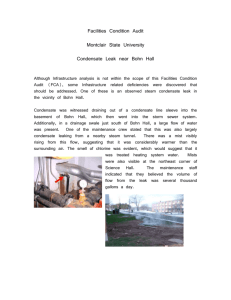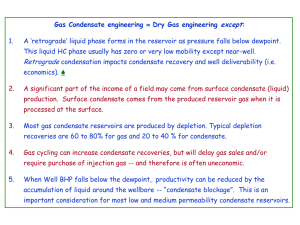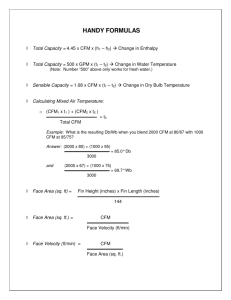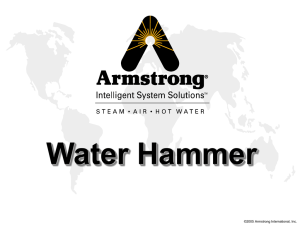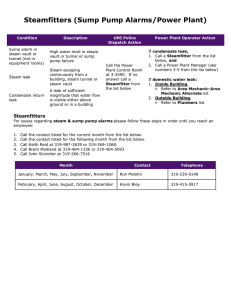SELECTION, INSTALLATION AND MAINTENANCE OF STEAM COILS
advertisement
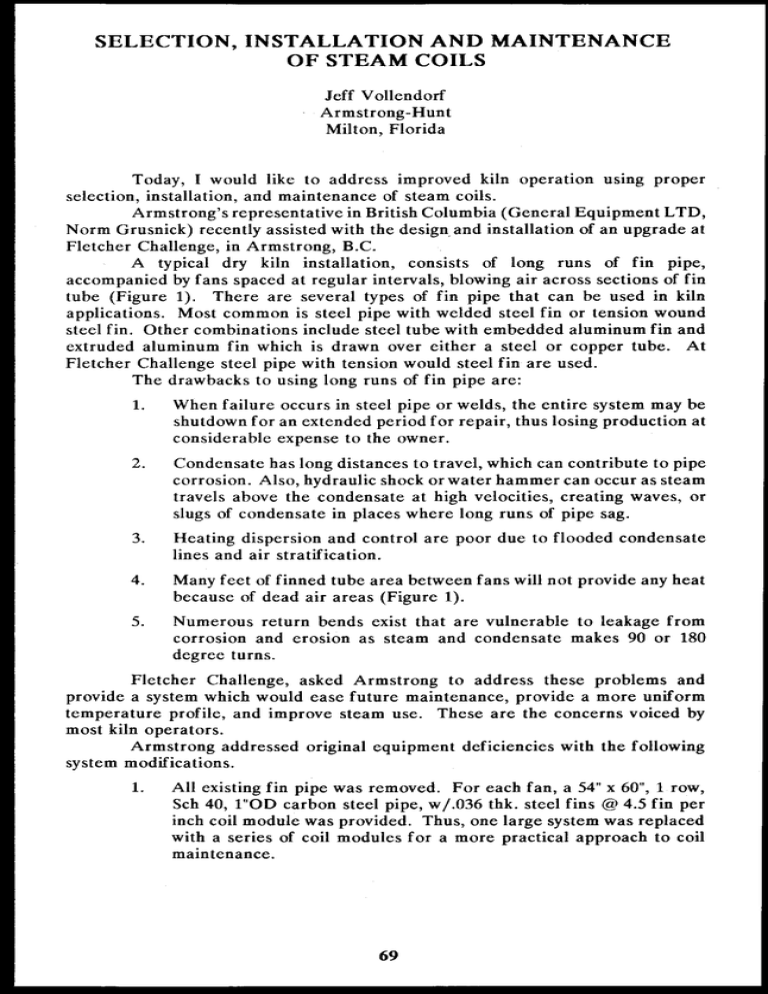
SELECTION, INSTALLATION AND MAINTENANCE OF STEAM COILS Jeff Vollendorf Armstrong-Hunt Milton, Florida Today, I would like to address improved kiln operation using proper selection, installation, and maintenance of steam coils. Armstrong's representative in British Columbia (General Equipment LTD, Norm Grusnick) recently assisted with the design and installation of an upgrade at Fletcher Challenge, in Armstrong, B.C. A typical dry kiln installation, consists of long runs of fin pipe, accompanied by fans spaced at regular intervals, blowing air across sections of fin tube (Figure 1). There are several types of fin pipe that can be used in kiln applications. Most common is steel pipe with welded steel fin or tension wound steel fin. Other combinations include steel tube with embedded aluminum fin and extruded aluminum fin which is drawn over either a steel or copper tube. At Fletcher Challenge steel pipe with tension would steel fin are used. The drawbacks to using long runs of fin pipe are: 1. When failure occurs in steel pipe or welds, the entire system may be shutdown for an extended period for repair, thus losing production at considerable expense to the owner. 2. Condensate has long distances to travel, which can contribute to pipe corrosion. Also, hydraulic shock or water hammer can occur as steam travels above the condensate at high velocities, creating waves, or slugs of condensate in places where long runs of pipe sag. 3. Heating dispersion and control are poor due to flooded condensate lines and air stratification. 4. Many feet of finned tube area between fans will not provide any heat because of dead air areas (Figure 1). 5. Numerous return bends exist that are vulnerable to leakage from corrosion and erosion as steam and condensate makes 90 or 180 degree turns. Fletcher Challenge, asked Armstrong to address these problems and provide a system which would ease future maintenance, provide a more uniform temperature profile, and improve steam use. These are the concerns voiced by most kiln operators. Armstrong addressed original equipment deficiencies with the following system modifications. 1. All existing fin pipe was removed. For each fan, a 54" x 60", 1 row, Sch 40, 1"OD carbon steel pipe, w/.036 thk. steel fins @ 4.5 fin per inch coil module was provided. Thus, one large system was replaced with a series of coil modules for a more practical approach to coil maintenance. 69 2. Ducted sheetmetal shrouds were made to extend from the fan to the coil, thus utilizing the entire coil surface area and eliminating excessive coil surface which adds to potential failures, and offers nothing but radiant heat. Note: upon startup with the new system, it was found that the static pressure drop in the duct was high enough to cause the existing fans to stall. to alleviate this problem, holes were opened up along the ductwork producing a smaller air pressure drop. If room is available, the duct can be sized to handle the airflow per fan; typical airflow required is 350 feet per minute. 3. Coils were hung from beams and each was individually piped and trapped. Inverted bucket traps were used because of their ability to handle dirt, withstand water hammer, and remove condensate quickly. Individually trapping each coil is the single biggest improvement that can be made in a system. By trapping each coil the following is obtained: A. Quick condensate removal. If not removed immediately condensate will reduce heat exchange by acting as an insulator between the steam and the pipe. B. Removal of noncondensible gases. A byproduct of normal operations, if left in the system, these gases lower the temperature of the steam-air mixture and also coat the pipe surface with an insulating layer that radically restricts heat transfer. C. Reduced condensate flooding of heat exchanger. By quickly removing condensate by means of a trap, three coil killers are eliminated; freezing, water hammer, and corrosion. 1) Improper drainage, causes condensate build up. If freezing air is allowed to come in contact with a flooded coil, damage will occur. Through trapping each coil, and using standard piping practices for coils, this problem can be greatly reduced. Some common piping practices are shown in Figures 2, 3, and 4. 2) Water hammer is created when a flooded or partially flooded system receives a shock. Thermal shock is the most likely cause of water hammer in steam-air coils. Thermal shock is generated when live steam enters a coil with subcooled condensate present. Steam can occupy approximately 1600 times the volume of an equal weight of condensate. When hot steam contacts the cooler condensate, the steam immediately collapses. The water rushes into the void from all sides impacting in the center and sending shock waves in all directions. This force, can rupture pipes and damage all parts of the system. Properly sized traps avoid this problem. 3) Corrosion is likely to occur in flooded coils. Carbon dioxide is a gas that is common in steam systems. As condensate cools, it mixes with any carbon dioxide that is trapped in the system and forms carbonic acid. Carbonic acid is highly corrosive, and an accumulation of this acid will destroy piping 70 and equipment. By quickly removing the condensate, you prevent this from occurring. At Fletcher Challenge, the traps were placed in a common area, providing easy access for maintenance; if a problem occurs it can be isolated and valved out,without shutting down the entire kiln. 4. Each coil was connected to the main header with quick coupling steam hoses, providing ease of maintenance. A spare coil can be quickly installed with very little down time or, if necessary, it can be quickly valved out. 5. Coils provided were designed with heavy steel fins to allow for high pressure cleaning using water or steam. In conclusion, the modular approach to kiln heating provided Fletcher Challenge with a system which reduced their fin surface area by 55% without compromising the drying time of the product. This was accomplished by providing an even air velocity throughout the kiln and improving their condensate removal. The system also reduced their maintenance and the possibility of equipment failure. This approach is becoming increasingly popular as an upgrade for conventional dry kiln heating systems. BIBLIOGRAPHY Armstrong Machine Works, M-101 Steam Conservation Guidelines for Condensate Drainage, Heating/Piping/Air Conditioning, December 1988. Walter T. Deacon and Thomas J. Clark - Armstrong Products. Tight specs reduce coil problems. Norm Grusnick, General Equipment. A review of problems and solutions, Fletcher Challenge, December 30, 1988. Figure 1. In the area between fans the air velocity is low resulting in very little convective heat transfer. These areas provide little more than radiant heat. 71 TEMPERATURE CONTROL VALVE El AIR VENT CHECK VALVE STEAM AIR COIL N VACUUM BREAKER STEAM SUPPLY LINE STEAM TRAP AIR FLOW SAFETY DRAIN STEAM ( TRAP CHECK VALVE Figure 2. Common piping practices. Overhead condensate return line for return system with backpressure. AIR VENT CHECK VALVE STEAM AIR COIL VACUUM BREAKER AIR FLOW CHECK VALVE >T<R--4>T</==1. RECEIVER CONDENSATE PUMP STEAM TRAP Figure 3. Common piping practices. Overhead condensate return line for return system with backpressure. TEMPERATURE CONTROL VALVE AIR VENT STRAINER STEAM AIR COIL VACUUM BREAKER STEAM SUPPLY LINE AIR FLOW STEAM TRAP CONDENSATE RETURN LINE Figure 4. Common piping practices. Condensate return line with no backpressure.
